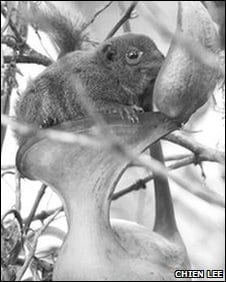Nepenthes pitcher plants and treeshrews maintain a mutually beneficial relationship by exchanging nutrients.
In Borneo’s tropical forests, a large, carnivorous pitcher plant, Nepenthes rajah, and a small mammal called a treeshrew have a great relationship. The pitcher plant lures the treeshrew in for some delicious nectar. While there, the mammal marks its feeding spot by dropping nitrogen-rich feces into the pitcher.
Pitcher plants have special leaves that form a tall jug, called a pitcher. They are best known for luring insects, especially ants, to the rounded rims of their pitchers. The rim of the pitcher has a slippery surface that causes insects to lose their grip and fall inside. Juices then digest the insects to release nutrients. However, Nepenthes rajah lives in a nutrient-poor area in the mountains that doesn’t have a lot of insects. So attracting, but not eating, the treeshrew is a good solution for getting additional nitrogen. At the same time, the treeshrew also gets fed. Nitrogen is important for and it helps the plant build leaves, roots, and stems.
Nepenthes rajah doesn’t have slippery surfaces because it’s not going to eat the treeshrew. Instead it has a special trick to get treeshrews do what the plant needs. Over the top of the pitcher is a lid, kind of like a toilet bowl lid (watch video). The lid angles upward over the top of the pitcher, and the nectar is on the edge of the lid. The distance from the nectar to the front of the pitcher’s opening is the exact same length as the treeshrew. This forces the animal to straddle the rim as it licks the nectar off the lid, and its feces drop directly into the pitcher.
This plant-mammal story can teach us the importance of meeting our own needs while also helping other people. Because it’s good for both parties, the relationship is likely to continue.







